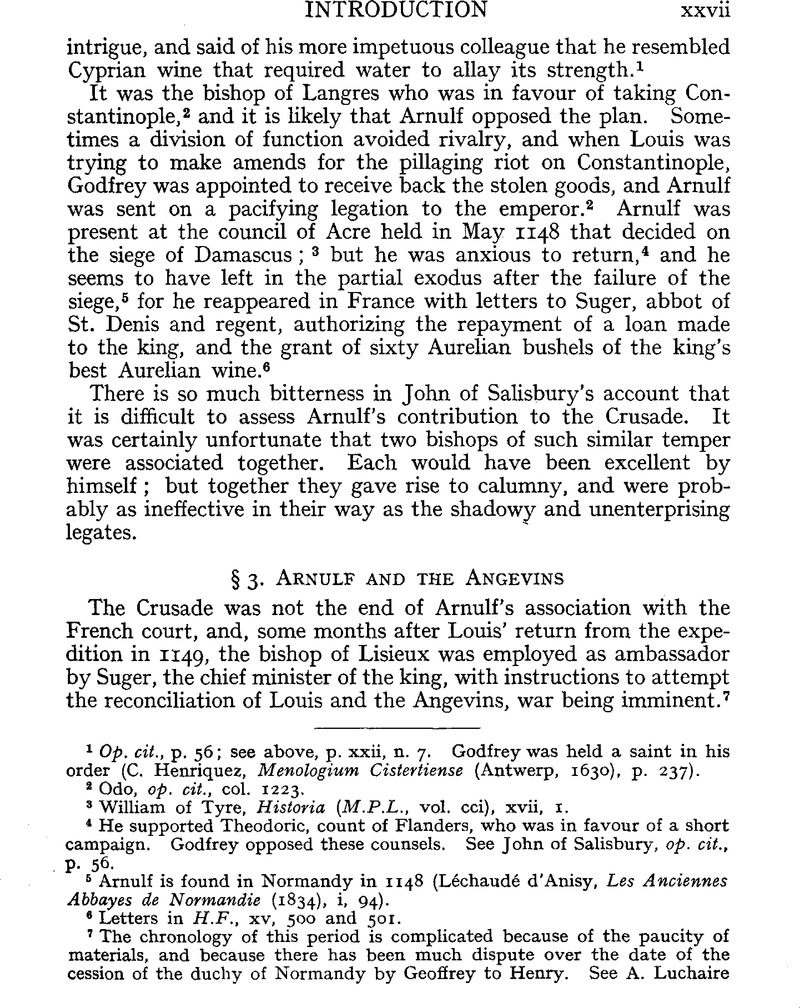No CrossRef data available.
Article contents
§3. Arnulf and the Angevins
Published online by Cambridge University Press: 24 December 2009
Abstract

- Type
- Introduction
- Information
- Copyright
- Copyright © Royal Historical Society 1939
References
page xxvii note 7 The chronology of this period is complicated because of the paucity of materials, and because there has been much dispute over the date of the cession of the duchy of Normandy by Geoffrey to Henry. See A. Luchaire (‘Sur la chronologie des documents et des faits relatifs à l'histoire de Louis VII pendant l'année 1150’ in Ann. de la Fac. des Lettres de Bordeaux, 1882) and Chartrou (L'Anjou de 1109 à 1151), who take divergent views of the date of the cession. Dr. R. L. Poole, disagreeing with both, argues for ante April 1149 (E.H.R., xlii, 596Google Scholar), and this date is supported by Arnulf's letter no. 4. Writing to Robert de Chesney, the newly-elected bishop of Lincoln, Arnulf congratulates him on his honour, and asks him to favour the cause of his duke, who ought to have the rule of England by hereditary right. As Robert became bishop at the end of 1148, the letter must have been written next year at the time of Henry's invasion, and Arnulf would make no mistake about the title.
page xxviii note 1 Suger to Geoffrey and Matilda, H.F., xv, 520Google Scholar; Arnulf, ep. no. 6; Geoffrey to Suger, H.F., xv, 521.Google Scholar
page xxviii note 2 Geoffrey to Suger, loc. cit.
page xxviii note 3 H.F., xv, 522.Google Scholar
page xxviii note 4 Torigni, p. 162.
page xxviii note 5 Recueil des actes de Henri II, roi d'Angleterre, ed. Delisle, L. and Berger, E. (Paris, 1909–1916)Google Scholar, i, nos. xi and xiv.
page xxix note 1 Haskins, , Norman Institutions, p. 163Google Scholar; Delisle-Berger, , op. cit., i, 43–4 etc.Google Scholar
page xxix note 2 Confirmation of Henry's charter by Richard I, dated 20 June 1189, printed by H. de Formeville, Histoire, i, ccccxxxv.
page xxix note 3 See below, p. liv.
page xxix note 4 Torigni, , p. 182.Google Scholar
page xxix note 5 Eyton, , ItineraryGoogle Scholar; Torigni, , p. 333Google Scholar. It is not clear whether Arnulf remained in Normandy until the king's return in January 1156. A later writer, Matthew Paris, states that he accompanied Rotrou of Evreux, William of Le Mans, and Robert, abbot of St. Albans, on a mission to the pope (Gesta Abbatum (Rolls Series), i, 126Google Scholar). Adrian IV, however, writing about the legation, substitutes G., dean of St. Lô, for Arnulf's name (Loewenfeld, S., Epistolae Pontificum Romanorum ineditae (Leipzig, 1885), p. 124Google Scholar). The legation was principally concerned with Henry's proposed conquest of Ireland (Matthew Paris, Chron. Maj., (Rolls Series), ii, 210Google Scholar), which had been discussed at Winchester on 29 September 1155 (Torigni, p. 186); but Adrian's bull shows that they also dealt with the election to the church of Angers, and the composition of the legation may have varied according to the business. We know that Arnulf visited Pope Adrian once (epp. nos. 14–15), but we prefer to ascribe that journey to 1157–9 (see below, p. xxxi), and this visit must be left in doubt.
page xxix note 6 Below, pp. 167, 169, 173 and 217; cf. pp. 67 and 125.
page xxx note 1 Below, pp. 14, 67, 173, 186 and 216.
page xxx note 2 Below, p. 169.
page xxx note 3 Below, p. 14.
page xxx note 4 He accompanied Henry on his progress through Aquitaine, and was at Bordeaux at Christmas (Delisle-Berger, , op. cit., ii, 431Google Scholar; Anon. Chron. in H.F., xii, 121). His name also appears as witness in many charters (Delisle-Berger, op. cit.).Google Scholar
page xxx note 5 Haskins, , op. cit., pp. 165–6.Google Scholar
page xxx note 6 Below, pp. 54–5.
page xxxi note 1 See below, p. xxxv. In reference to a matter which arose out of the struggle he appears to call Henry a tyrant (below, p. 21).
page xxxi note 2 See below, p. xl.
page xxxi note 3 See below, p. 50; cf. pp. 16, 94, 165, etc.
page xxxi note 4 Poole, R. L., ‘The Early Correspondence of John of Salisbury’ in Studies in chronology and history (Oxford, 1934), p. 278Google Scholar, and Webb, C. C. J., John of Salisbury (London, 1932), pp. 18 and 103.Google Scholar
page xxxi note 5 Ep. no. 121, Materials, v, 105Google Scholar; cf. ep. no. 108.
page xxxi note 6 The only evidence that Arnulf visited the papal court and intrigued against John on his return is Peter of Celle's statement that a person de curia, who was with him, had related the story (ep. no. 67; M.P.L., ccii, 513Google Scholar), and later John blames Arnulf for it (loc. cit.). The absence of the bishop from court also inclines Dr. Poole to think that he went to Rome, but his absence can be explained in many ways.
page xxxi note 7 Ep. no. 14.
page xxxi note 8 Ep. no. 15.
page xxxii note 1 Anon. I, Materials, iv, 29Google Scholar; William of Canterbury, ibid., i, 14.
page xxxii note 2 ‘sollicite laboravit die ac nocte ut pax fieret inter regem et archiepiscopum, sed ad plenum fieri non potuit’. Chronica Rogeri de Hovedene (Rolls Series, 1868–1871), i, 220–1.Google Scholar




